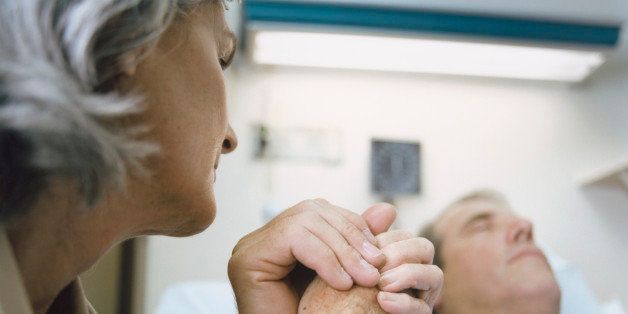
In our minds, the Venn diagram of life and death consists of two separate circles. Maybe we think about it this way because it makes it easier to sleep at night, knowing that being alive is an absolute truth powerful enough to preclude death.
Nowadays, we even separate our living spaces from the places we die. We rarely bring death home, preferring instead to keep it in places like cemeteries and crematoriums, where it can stay cozy and contained, and where it has no need to spill over the barrier and infiltrate our secure existences.
Death is acceptable, but only from a distance. We believe that it has its time and place, and will only happen when we're good and ready to jump across and leave everything behind.
I know many people hate hospitals because they associate them with dying, just like they do with cemeteries. I don't consider myself a particularly emotional person, but even I feel distressed and uncomfortable in the face of death. Like everyone else, I avoid the cemeteries, crematoriums, funerals, and the rest of it.
Faith helps us reconcile with death and look it in the eyes with respect. Death, in turn, reminds us to be what we are, but better and brighter.
Death is not a friend, but a distant relative I have to meet once in a while. He always irritatingly reminds me to swallow my chalky multivitamin and savor the finite amount of time I have left on this earth.
Part of my job as a volunteer in a hospital is to supervise family visits with patients who have just come out of surgery, as well as help families feel comfortable and stay updated while their loved ones are under the scalpel.
In the first few weeks of volunteering, I found it difficult to acknowledge the possibility of death. It felt wrong to even say the word, like I was tempting fate. The patients I saw during my shifts recovered well from their surgeries. As I passed by their beds, they talked to me about which steakhouse they wanted to eat at, or about the antics of their five grandchildren. But I knew death had to be somewhere in the hospital, and I didn't want to notice. I was here to be helpful and watch people save lives. I wanted no part of death.
During every shift, however, I couldn't help but stare at life and death sitting next to each other in the waiting room, like old friends instead of arch-rivals, anticipating what their futures held.
That's one of the things that make hospitals unique, though. In a world where it is virtually impossible to reconcile life and death, we find them comfortably cohabiting in this liminal space. And to be honest, when I first started volunteering there, their co-presence was kind of disorienting.
I couldn't help but stare at life and death sitting next to each other in the waiting room, like old friends instead of arch-rivals, anticipating what their futures held.
I wasn't related to anyone I talked to during my shifts, but as they waited to hear an update from the operation room, their hesitance was palpable. The reality of death was haunting, and by attempting to avoid the subject of death, it inevitably became all I could think about.
How do you live as a physician, as a surgeon, and grapple with the truth of life and death while you literally hold someone's heart in your hands? More importantly, how does a person navigate the foggy corridor between life and death when their spouse, child, sibling, is on the operating table? How do you look death in the eye and acknowledge that it's sitting next to you on the couch, sipping free waiting room coffee and flipping through a magazine?
Sure, it might leave you alone in a few hours when the surgery is finished and you hear that your loved one is in the clear. For a short time, though, the murky unknown zone between life and death needs to be confronted. As hard as we try to ignore it, death demands to be acknowledged.
When death asks to be noticed, you respond with faith.
Faith is subjective, but it rings as true as fact. It's found in religion, but it doesn't always have to be concretized that way. I like to think that faith is the reason people have the strength to stay for hours on end in the waiting room, looking for an update or a sign that death is not here to stay today.
It's in the confidence and wisdom of the surgeon who takes people apart to save their lives and then sews them back together, as well as in the dedication of other doctors, nurses, and employees whose work is a matter of life and death. Where people see death in hospitals, I see faith. The power of faith is intoxicating, and that is why, when I weighed my options of faith, fear, and denial, I chose faith.
The truth of the matter is we are all going to die. Some of us will die in our sleep at the golden age of 92. Some of us will have a fatal stroke at 24. The worst part is, there's no way to tell for sure where we lie on this spectrum -- and even if we could, would we really want to know?
Faith helps us reconcile with death and look it in the eyes with respect. Death, in turn, reminds us to be what we are, but better and brighter. Death is not grief, though it can cause grief, which is what follows us home from the hospital and always overstays its welcome. But death is a reminder of our humanity, and it invigorates our faith. It isn't a distinct reality; it's the other side of the coin. And while we avoid it and push it to the edges of our consciousness, it is there, sipping coffee and reminding us to take our vitamins. The real question is not whether we will encounter death, but rather is our faith strong enough to fight for life in spite of it?
